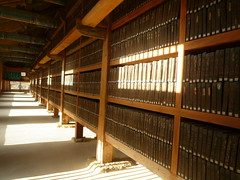Haeinsa temple
I had a random Thursday off school, so I finally had a chance to head out to Haeinsa temple, UNESCO world heritage site and one of the few places left on my Must Visit list in Korea.
On the way I stopped by Daegu and found that the street market selling traditional medicine goods wasn't nearly as interesting as that sounds. The Insam festival had a much more interesting variety of traditional medical items, so I quickly continued onward.
Outside the temple there was a phone booth with a roof made to look like a temple. Far more impressive was the tree that was planted at the founding of the temple in 802 CE and grew next to it for over a millennium until it finally died in 1945. Inside the gates was a contemplative labyrinth, which is always there but was decorated with colorful flags and lanterns for some event that day (there was also a mic check in progress and the inner courtyard was covered with black netting that shaded the area except for a hole to allow a pagoda to poke out). The temple is mostly a fairly ordinary Korean temple with perhaps a larger than usual (fairly new) pagoda on an inaccessible hill behind the complex, except that it is the storage place for the Tripitaka Korana. The Tripitaka Koreana is a Buddhist cannon and Koreans claim that it is the first book in the world to be printed with movable type (although for some reason the Koreans didn't use this technology for printing any other books and didn't seem to make all that many copies of this one, and really the type isn't movable, it was movable before it was fixed into the page). The Tripitaka's 52 million Chinese characters were carved onto 81,340 wood blocks and are housed in an old building that regulates temperature and moisture better than the modern museum they planned to replace it. The temple also holds 2,835 other blocks from the Goryeo period. The picture you see is the first floor of one half of one side of the two story rectangular building. The temple has caught fire numerous times though the part with the wood blocks were always spared, and they also survived several wars (including the Korean civil war where a South Korean pilot disobeyed his orders to bomb it).
When I left the temple I saw what seemed to be a small army of monks meticulously cleaning the grounds, sweeping up every leaf. I enjoyed the fall colors on the trees as I walked back to the visitors center, which had a small museum that included copies of the woodblocks that you could use to make your own prints of one page. For about $3,000 you can get a printed copy of the whole massive work.
On the way I stopped by Daegu and found that the street market selling traditional medicine goods wasn't nearly as interesting as that sounds. The Insam festival had a much more interesting variety of traditional medical items, so I quickly continued onward.
Outside the temple there was a phone booth with a roof made to look like a temple. Far more impressive was the tree that was planted at the founding of the temple in 802 CE and grew next to it for over a millennium until it finally died in 1945. Inside the gates was a contemplative labyrinth, which is always there but was decorated with colorful flags and lanterns for some event that day (there was also a mic check in progress and the inner courtyard was covered with black netting that shaded the area except for a hole to allow a pagoda to poke out). The temple is mostly a fairly ordinary Korean temple with perhaps a larger than usual (fairly new) pagoda on an inaccessible hill behind the complex, except that it is the storage place for the Tripitaka Korana. The Tripitaka Koreana is a Buddhist cannon and Koreans claim that it is the first book in the world to be printed with movable type (although for some reason the Koreans didn't use this technology for printing any other books and didn't seem to make all that many copies of this one, and really the type isn't movable, it was movable before it was fixed into the page). The Tripitaka's 52 million Chinese characters were carved onto 81,340 wood blocks and are housed in an old building that regulates temperature and moisture better than the modern museum they planned to replace it. The temple also holds 2,835 other blocks from the Goryeo period. The picture you see is the first floor of one half of one side of the two story rectangular building. The temple has caught fire numerous times though the part with the wood blocks were always spared, and they also survived several wars (including the Korean civil war where a South Korean pilot disobeyed his orders to bomb it).
When I left the temple I saw what seemed to be a small army of monks meticulously cleaning the grounds, sweeping up every leaf. I enjoyed the fall colors on the trees as I walked back to the visitors center, which had a small museum that included copies of the woodblocks that you could use to make your own prints of one page. For about $3,000 you can get a printed copy of the whole massive work.

0 comments:
Post a Comment